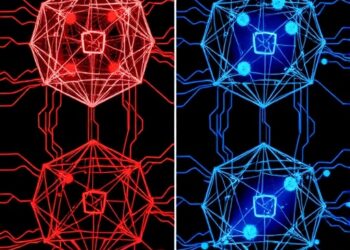The world of electronics is witnessing a significant transformation with the advent of two-dimensional (2D) semiconductors, which offer remarkable properties conducive to advanced electronic applications. Despite their promising potential, the production of high-quality 2D semiconductor wafers with specifically engineered layers has long remained a challenge in the realm of material science. This notion sets the stage for groundbreaking research that explores a new direct wafer bonding and debonding method aimed at enhancing the fabrication processes of such semiconductors.
At the heart of this research lies the innovative technique that allows for seamless bonding and debonding of semiconductor monolayers. This method is particularly noteworthy due to its applicability to monolayers that are epitaxially grown on high-adhesion substrates like sapphire, a material known for its sturdy properties. The ability to operate in both vacuum environments and glovebox settings is a significant advancement, as it opens up new avenues for the creation and manipulation of these materials without the hindrance of intermediate layers that are often required in traditional approaches.
One of the key advantages of this direct bonding approach is the resultant clean interfaces it produces, which are essential for ensuring the optimal performance of electronic devices. The uniformity across the wafer scale that this technique achieves is crucial for the practical application of 2D semiconductors. Such precision in controlling the number of layers and the angles at which these layers are twisted offers unprecedented opportunities to design materials tailored for specific functionalities in devices ranging from transistors to sensors.
Molybdenum disulfide (MoS₂) and molybdenum diselenide (MoSe₂) are two examples of 2D monolayers where this method has been applied to create both homostructures and heterostructures. The significance of these materials lies not only in their semiconductor properties but also in their ability to be integrated into various electronic architectures. By stacking these monolayers with a precise understanding of their properties, researchers can engineer devices that exhibit enhanced functionality and efficiency, making them suitable for next-generation electronics.
An especially intriguing facet of this bonding technique is its ability to directly bond monolayer MoS₂ onto high-κ dielectric substrates such as hafnium oxide (HfO₂) and aluminum oxide (Al₂O₃). Past challenges in achieving such direct bonding often led to alterations in the intrinsic electronic properties of the materials involved. However, this novel method preserves the essential characteristics of MoS₂, which is vital for maintaining the electronic integrity and performance of the devices being developed.
This development introduces a myriad of implications for the field of electronics. It not only addresses the long-standing issues of layer quality and interface integrity but also fosters an environment where more complex device architectures can be explored. The precision that this method brings to layer stacking opens up new pathways for research into the electronic, optical, and chemical properties of 2D materials.
The technological implications extend beyond just the 2D semiconductors themselves; they also offer insights into potential applications in photodetectors, transistors, and even quantum computing. The ability to create customized materials through layer manipulation promises advancements in how devices can be constructed, offering a pathway for creating highly efficient and compact electronic systems that harness the unique properties of 2D materials.
Moreover, the environmental adaptability of the bonding and debonding process signifies progress in the accessibility of these advanced materials. High-adhesion substrates and a flexible operational environment mean that researchers can apply this method under varied conditions, thus facilitating a broader scope of experimentation and industrial application. The removal of interlayer assistance also suggests a reduction in the complexity and cost associated with traditional methods of layer fabrication.
As the field continues to evolve, the research highlights the importance of collaboration between material scientists, electrical engineers, and manufacturers to fully realize the potential of 2D semiconductors in practical applications. This collaborative approach will be essential in addressing the remaining challenges of scaling up production and ensuring consistent quality across larger wafer sizes.
In conclusion, the development of a direct wafer bonding and debonding technique marks a pivotal moment in the exploration of 2D semiconductors. As researchers delve into its wide-ranging applications, the promise it holds for future electronics is immense. The ability to customize and manipulate these materials with high precision can potentially lead to a new era of technology that harnesses the power of 2D semiconductors, steering innovations in communication, computing, and beyond into an era defined by unmatched efficiency and functionality.
The impact of this research positions it at the forefront of semiconductor technology. As it garners attention across the scientific community, the hope is that it will inspire further investigations into the properties and applications of 2D materials. This knowledge is not just about advancing technology; it’s about paving the way for the next generation of devices that can push the limits of what is currently possible in electronics, ultimately leading to significant shifts in how we interact with technology on a day-to-day basis.
In summary, this innovative exploration into the direct bonding and debonding of 2D semiconductors exemplifies the relentless pursuit of scientific advancement. It demonstrates a remarkable stride toward overcoming the inherent challenges faced in the fabrication of these cutting-edge materials and embodies the spirit of exploration that propels the field of electronics forward. As the research unfolds, we remain poised to witness a transformation in the landscape of technology, driven by the capabilities of 2D semiconductors.
Subject of Research: Two-dimensional semiconductors bonding and debonding techniques
Article Title: Direct bonding and debonding of two-dimensional semiconductors
Article References:
Liu, J., Zhao, J., Li, T. et al. Direct bonding and debonding of two-dimensional semiconductors.
Nat Electron (2025). https://doi.org/10.1038/s41928-025-01474-3
Image Credits: AI Generated
DOI:
Keywords: 2D semiconductors, wafer bonding, MoS₂, MoSe₂, electronic applications, high-κ dielectrics




